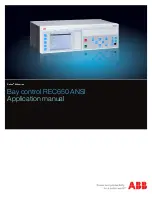
5-12
Stinger® FS/Stinger FS+ Getting Started Guide
Configuring Control Modules and System Timing
Providing a basic system IP configuration
the host portion of the IP address is all 0s (zeros). For example, suppose that the
Stinger configuration assigns the following address to a remote router:
198.5.248.120/29
The Ethernet network attached to that router has the following address range:
198.5.248.120 — 198.5.248.127
A host route is a special-case IP address with a prefix length of /32. For example:
198.5.248.40/32
Host routes are routes to a single host, rather than to a network or subnet. This is
determined by the fact that a 32-bit netmask does not allow for any host addresses on
the network, other than the single address that is specified. It is, in effect, a
one-address subnet.
Assigning administrative Ethernet IP addresses
A Stinger unit creates an IP interface for the Ethernet ports of each control module.
Use the Dir command to list the IP interfaces. The following example shows the
10/100Mbps administrative Ethernet interfaces on two standard control modules.
admin>
dir ip-interface
18 03/06/2003 16:36:32 { { any-shelf any-slot 0 } 0 }
29 03/06/2003 16:27:57 { { shelf-1 first-control-module 1 } 0 }
18 03/06/2003 23:53:47 { { shelf-1 second-control-module 1 } 0 }
The designations
first-control-module
and
second-control-module
refer
to slot positions 8 and 9 respectively, not the primary or secondary status of each
control module. The IP-Interface profile with the zero index (the default
any-shelf
any-slot
index) is reserved for the soft interface, which is described in “Defining
the soft IP interface for fault tolerance” on page 5-13.
Two standard control modules are shown in this example. The control module shown
above in the first control module slot position is the primary control module. The
following commands assign to the primary control module the address 1.1.1.1/24:
admin>
read ip-interface { { shelf-1 8 1 } 0 }
IP-INTERFACE/{ { shelf-1 first-control-module 1 } 0 } read
admin>
set ip-address = 1.1.1.1/24
admin>
write
IP-INTERFACE/{ { shelf-1 first-control-module 1 } 0 } written
The following commands assign the address 1.1.1.2/24 to the secondary control
module:
admin>
read ip-interface { { shelf-1 9 1 } 0 }
IP-INTERFACE/{ { shelf-1 second-control-module 1 } 0 } read
admin>
set ip-address = 1.1.1.2/24
admin>
write
IP-INTERFACE/{ { shelf-1 second-control-module 1 } 0 } written
After you assign IP addresses, you can verify that the Stinger unit is a valid IP host on
its configured network by pinging other network hosts, as shown in the following
example:
admin>
ping 1.1.1.56
PING 1.1.1.56: 56 Data bytes
















































